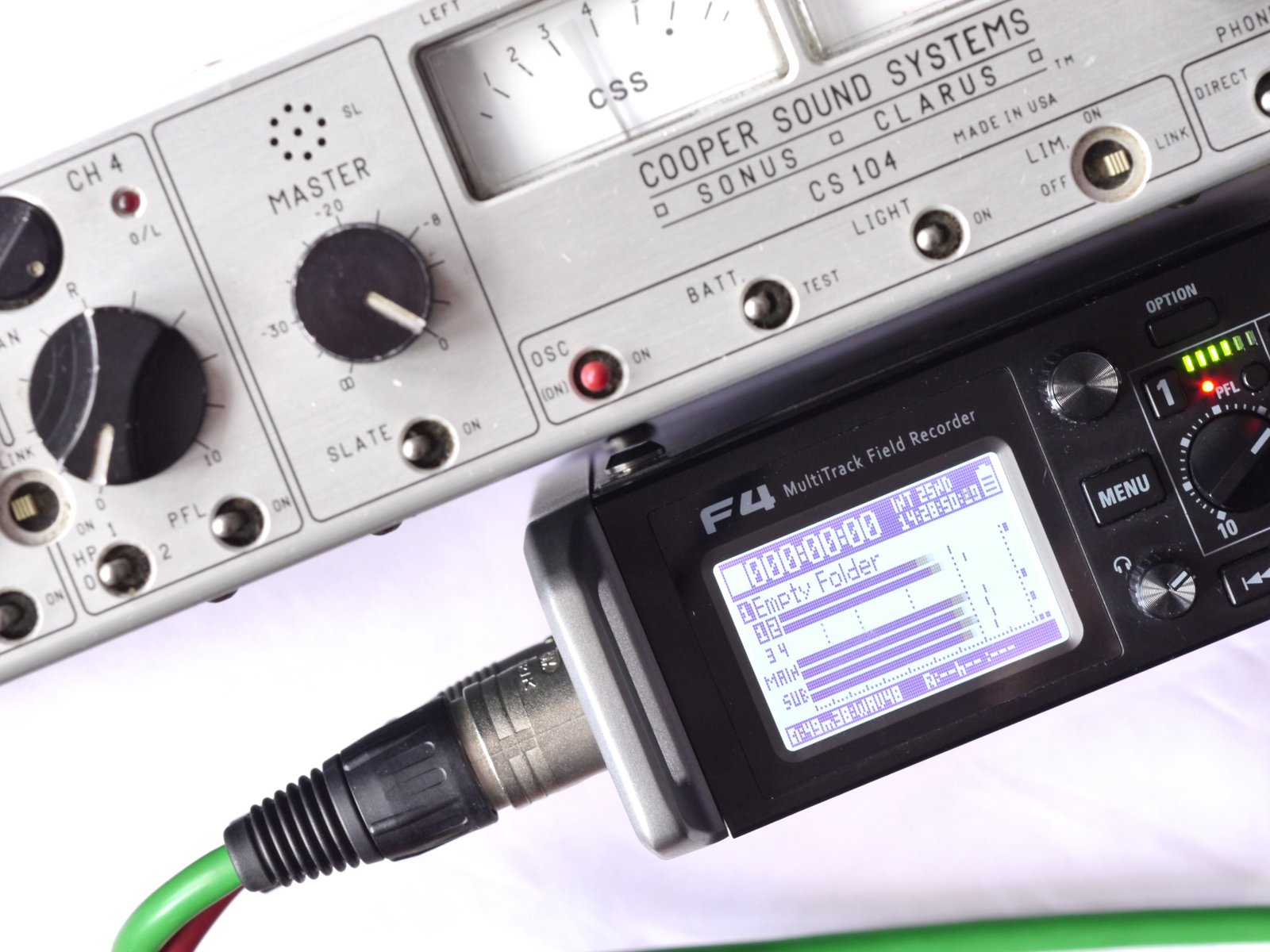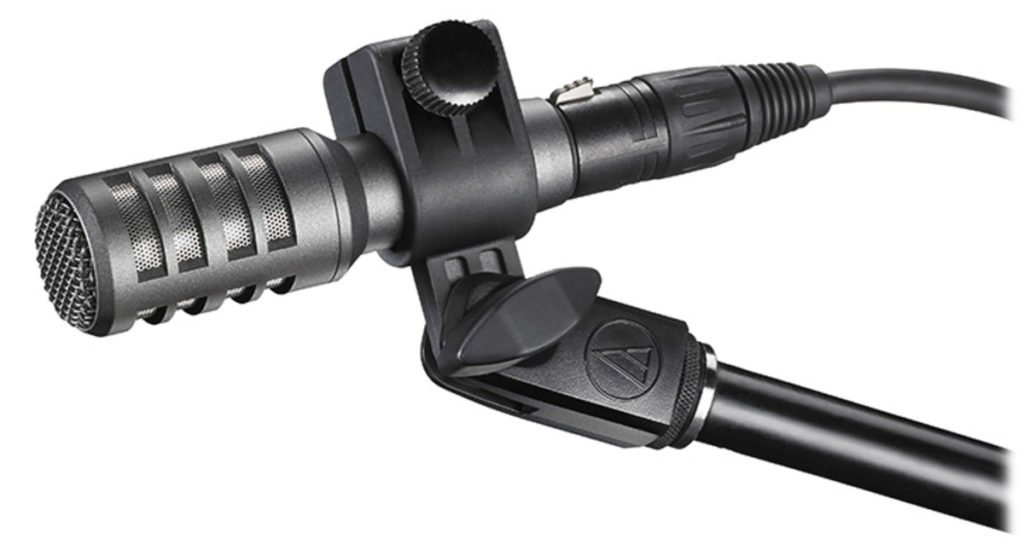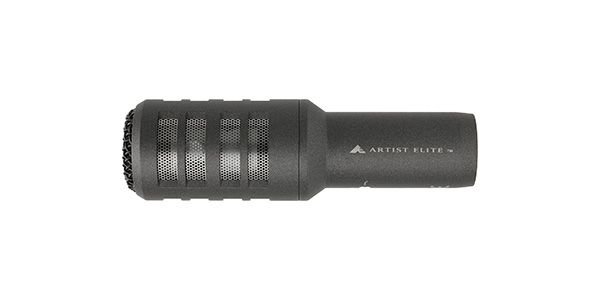As any fule knows – Made in Japan – Deep Purple’s magnum opus is one of the greatest rock records ever made. Strangely though at the time the title might even been ironic, Made in Japan was uncool. But now Made In Japan is something we recognise as an almost guaranteed good thing. Which makes me wonder why Audio Technica are a little coy about it. It’s written it in tiny letters on the back of the AE2300 box – the font on the mic itself looks bigger. I would have it proudly in 40pt font all over everywhere. This microphone is made in Japan!
Anyway, the AE2300 is a new dynamic instrument mic from Audio Technica and its made in Japan. Beautifully made, it must be said, and dinky enough to be cute, about half the length of a Beyer 201. Not only is the AE2300 a thing of beauty it’s clip or more properly clamp is also finely engineered and screws down hard enough to ensure your AE2300 doesn’t escape into the wild – even when your Ian Paice wannabee drummer bludgeons it. And of course this is fine because the AE2300 is intended as an instrument mic, Ian Gillan doesn’t get to play with this one.
So of course the first thing I did was try it on vocals – well speech rather. But forgive the tease – more of that later. I don’t have a huge number of dynamic mics in the cupboard – mostly Beyerdynamics with the obligatory sprinkling of SM58s or 57s if I take the screen off! And do you know that’s where I thought I would start. A 57 and the AE2300 on a snare, because – well why wouldn’t you?
I’m always conscious when testing gear that new gear has no history – my 58s look pretty tidy but all live mics lead a hard life sooner or later and who knows whether they sound as good as a freshly unwrapped 58 from Mr Shure. With the proviso out of the way – what did they sound like? Well the Audio Technica is over the twice the price and it is over twice as good. The top end of the AE2300 is more extended in a way that brings crispness and definition – it was chalk and cheese. So are you writing on a blackboard or making a sandwich? I say that because the wider audio window of the AT will make you work harder when it comes to keeping hf stuff you might not want out of your snare sound. But for me the AE2300 was a bit of a revelation. If you want the hard edges in your snare then the AT delivers them are sharp as you like.
Next the Beyer 201 – a much under appreciated mic. And at this point I should say the AE2300 is about the same sensitivity as the 201, meaning that you need a lot of gain if your source is a quiet one and therefore you need a mic amp with good noise performance. On the other hand if you are working with a loud rock kit or stack turned up to 11 then the AE2300 will handle the spl without any problems. The 201TG is a much better competitor for the AE2300 and indeed closer in price, though a handy chunk cheaper. This is a much tighter battle, the 201 is known for its extended high end in dynamic mic world, but again the AE2300 comes out top. If you excuse the pun. In terms of polar diagram the 201 is a hypercardioid and with the tighter pattern you get significantly better rejection with the 201 – maybe as much as 6dB in my ad hoc measurements at 90 degrees incidence. However life is never simple and alongside the amount of rejection we want to be thinking about the tonal quality of the off axis audio and here I felt the AE2300 held more of the cards.
At the bottom end of the kit I tried the AE2300 alongside the Beyer M99 – another hypercardioid – and probably half as much again in cost. You probably won’t be reaching for the AT as your first choice – because straight off you’ll have more spill and that extra top end will need to be dealt with , but careful positioning and judicious treatment and it could work. I ought to say something about physicality and here the AE2300 is a joy – the shortness of the barrel makes placement that bit easier and the narrow diameter of the rear section of the mic means that even when firmly screwed down in the clamp the horizontal dimensions are kept to the minimum.
Sadly I didn’t have a brass section to hand – where are they when you need them! But on a guitar cab the extended top end offers a lot of a, b and c – attack, bite and crispness. In fact if I had a query about the 2300 it would be whether there is too much zip at the top end. Which brings me back to that speech test I did at the beginning.
Setting aside dynamics for the moment I dug out an AKG Blueline 391 – that is the 300B amplifier and a CK91 cardioid capsule, which on the street will cost you maybe ten or fifteen percent more than the Audio Technica. Side by side on speech it is very easy to tell them apart, the AE2300 has considerably more top end. To the point where I was reaching for, if not a de-esser then at least a gentle shelf above five Khz. But actually having applied the eq I was impressed by the intrinsic quality of the AT when really we would expect it to be out of its comfort zone up against a condenser mic on speech. To bring it all home I think the AE2300 is one of the most exciting prospects in dynamic mics for a long time. In a world where exotic large diaphragm condensers tend to hog the lime light here is a dynamic workhorse that will probably be more relevant in the day to day search for better sound. Smoke on the Water then.



